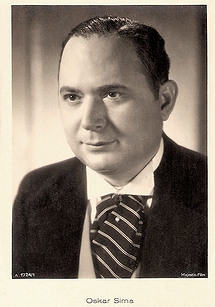به ازای هر نفری که با دعوت شما در منظوم ثبتنام میکنند 20 امتیاز میگیرید.
لینک دعوت:


Sima's screen career commenced in 1921. He made limited headway until the arrival of sound. All of a sudden, he started to average several films per year, often acting in commercially successful pictures like Die Fledermaus (1931), So ein Flegel (1934), Liebe, Tod und Teufel (1934), Glückskinder (1936), Gasparone (1937), Frau im Strom (1939) and Jenny und der Herr im Frack (1941). His stock-in-trade character was the surly curmudgeon: sometimes villainous, cigar-chewing and choleric, sometimes shifty and scheming, all the while deceptively amiable. At other times, he provided effective, often scene-stealing comedy relief, as pompous, easily deflatable editors, industrialists or burgomasters. Sima continued, unabated, during the post-war era, alternating comedies with romantic melodramas. In 1967, he was forced into retirement following a heart attack, retreating to his horse-breeding stud near Vienna.
During the national socialist era, Sima's stance towards the ruling regime seemed ambivalent. On the one hand, he vociferously applauded Austria's 'Anschluss' with Germany. He went as far as to join the NSDAP, ostensibly, in order to continue performing. On the other hand, Sima appears also to have been associated with at least one resistance cell during the 1940's. Perhaps, that curious ambiguity accounted for his receiving the one major award of his prolific career, the Filmband in Gold, only just prior to his death in June 1969.